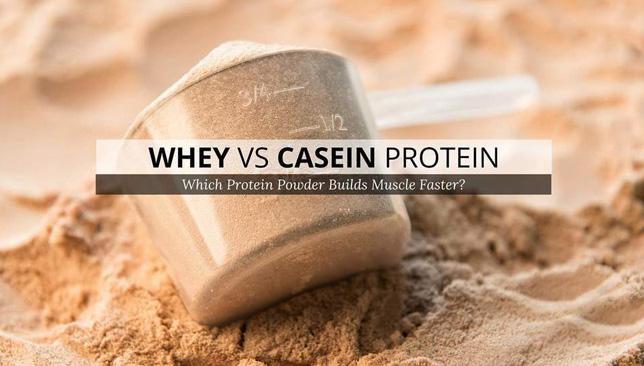
Protein powder supplements are an important aspect of a muscle-building program. They allow you to hit your required daily target of around a gram of protein per pound of bodyweight without breaking the budget or taking in too many excess calories. Here we put two major sources of protein (whey and casein) head to head to see how they stack up.
WHEY AND CASEIN SOURCES
Both whey and casein protein is sourced from the milk of cows, goats or any other mammal. 80% of milk protein is casein, while 20% is whey. Whey is the cottage cheese like film that forms on the top of milk. For many years whey was simply skimmed off and thrown away. That was until researchers discovered that it was a great source of amino acids and was more readily digested than casein.
THE ABSORPTION RATE MYTH
The conventional wisdom will have us believe that whey protein is a fast acting protein, and should, therefore, be taken when you need to get protein to your muscle cells quickly, such as first thing in the morning or straight after your workout. Casein, on the other hand, is known as a slow absorbing protein which you should take when you want a prolonged release of protein, such as just before going to bed. The reality of the human body is that all proteins are absorbed slowly.
The entire process of digestion and absorption of nutrients is a lot slower than most people imagine. This is particularly the case when it comes to protein. Whey protein, when consumed in isolation, is absorbed at a rate of between 8-10 grams per hour whereas casein is absorbed at a rate of 6 grams per hour. The reason Casein is absorbed slightly slower is due to the delayed gastric emptying when the casein protein forms a gel like substance in the gut. When combined with other macro-nutrients, the rate of digestion for both proteins takes even longer.
The bottom line here is that focusing on the comparative absorption rates between whey and casein is a non-issue. The slow absorption rate of whey is going to provide your body with a ready supply of protein to feed your muscles over a 24 hour period.
BIOLOGICAL VALUE
The biological value of a protein refers to the amount of the protein that is actually used by the body. The simple fact is that whey protein has the highest biological value of any protein source, including whole foods. Not only does casein have a lower biological value than whey protein, it has a lower value than many whole food sources of protein, such as beef, milk and eggs. So, when it comes to biological value, whey is leading the charge.
AMINO ACID PROFILE
Some amino acids are more valuable than others when it comes to building muscle. There are 22 amino acids, 8 of which are known as essential amino acids. They are essential because the human body cannot manufacture them, meaning that they have to come from the foods we ingest. Whey protein has the best amino acid profile in terms of providing the essential aminos. Not only does it beat out casein, it also has a higher amino acid profile than any whole food protein source. The superiority of whey protein is largely due to it’s branch chain amino acid profile. The branch chain amino acids – L-leucine, L-valine, L-isoleucine – are the most anabolic of all the aminos, and whey simply gives you more.
USABILITY
Whey protein mixes more readily and tastes better than casein does. If you’ve ever tried to combine other food, such as banana or berries, with a casein smoothie, you’ll know how difficult this can be. Even without additives, casein generally mixes into a thick sludge, whereas whey usually mixes up smoothly and remains more liquidy without forming a gel. Most people, however, find that casein protein helps to curb their appetite better than whey. Milk, for example, is 80% casein and 20% whey. That’s why it does such a good job of filling us up.
Many protein powders are a blend between whey and casein protein.
KEY POINTS:
Article provided by: Nutrition Souq